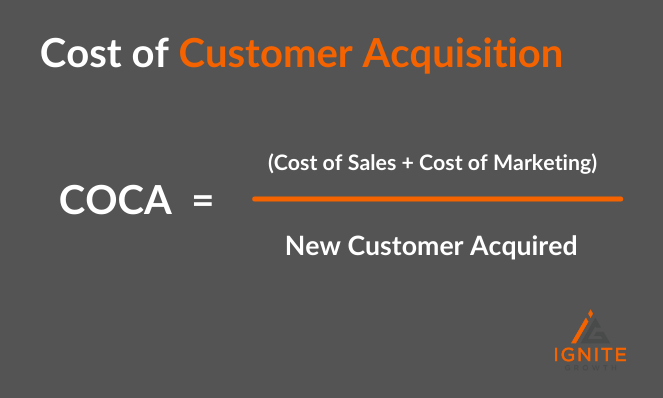When planning out a growth strategy, it is important to be realistic with your goals and give yourself milestones and metrics to hit across the year, so that your business growth is predictable and scalable.
I run through the thought process in this video that I recorded when running a workshop with Barclays Business Bank.
So let’s run through each metric and why we need to know this.
1. NET NEW Revenue Goal – Next 12 Months
The starting point is to set yourself a specific revenue goal for the next year and work back from there.
Be specific here i.e “I want the business to be turning over £2m by December 2022” Where are you now and what is the net new revenue you need to generate to hit this goal ?
You should now know your “Net New” revenue goal – “We need to make £500000 of net new revenue to hit our overall revenue goal.”
2. CURRENT AVERAGE ORDER VALUE (AOV)
if you are using a CRM such as Hubspot you should have this figure to hand. At least if you are segmenting your customers and orders correctly.
Again this is vital, as it will dictate how many net new customers you need to generate to hit your revenue goal.
For example if your average order value is £5000 then to hit your £500k of net new revenue you will need to generate 100 new customers over the next 12 months, assuming everything else remains equal.
3. NET NEW CUSTOMERS REQUIRED
As discussed above, once you know your average order value, this is not a difficult calculation and is simply dividing the net new revenue by the average order value.
Now your Sales Team have two solid metrics to aim for, Net new Revenue to generate and New Customers to close.
But don;t let your Marketing Team off the hook, their role is to use “Sales Enablement” tactics to support sales in hitting this goal. Do not let marketing think they are not responsible for revenue.
4. AVERAGE SALES CYCLE LENGTH
It is important at this stage to be realistic with your planning and stop to assess where you are with your sales process and pipeline management.
How long does it take to close the average sale ? Is it 3 montth, 6 months or 12 months ?
Again your sales team should be all over this figure and constantly trying to reduce this time, again with the support and help of marketing.
5. LEAD CONVERSION % – LEAD TO CUSTOMER
One of your key sales metrics is your conversion rate of lead into customer. The higher quality the lead and the better fit the prospect to your services, products and solutions – the higher your conversion rate.
The average conversion rate will vary by sector but I would expect a minimum of 20%, or one in five leads generated being turned into a customer and revenue.
6. NUMBER OF NET NEW LEADS REQUIRED
So now you know how many net new customers you need i.e 100 at £5000 to produce £500k net new revenue. You also know you are converting leads into customers at 20%, so you now know that you need to create 500 leads for sales.
The significance of this, is that you can improve this conversion rate and by simply getting this to 25%, you will reduce the number of leads you need from 500 down to 400.
7. WEBSITE CONVERSION – VISITOR TO LEAD
So marketing can now audit their current lead sources and optimise them to produce the number of leads reauired. Marketing campaigns can target the segments of customers who are “best fit” for your business and attract more of these prospects, who are more likely to convert at a higher level for the sales team.
Your website should be producing a good proportion of your new leads every year. So focus on knowing what your conversion rate from website visitor to lead is.
Aim for 2% – I regard best practice as optimising your website conversion with landing pages, calls to action and conversion offers to give you a minimum of 2% conversion of traffic into leads in your CRM.
8. WEBSITE VISITORS REQUIRED
Make sure you are measuring and optimising the performance of your website to predictably hit 2% conversion and then you know to generate 500 leads, you need to generate website traffic of 25000 per year, which sound a big figure, but that is just over 2000 visitors per month, so very achievable by most businesses.
Remember that you can use paid search and social media campaigns to drive highly targeted traffic to specific relevent landing pages and this will give far higher conversion rates than sending traffic to your homepage.
IGNITE POWER TIP: Set up custom audiences for remarketing to website visitors. This can increase conversion by 25%.
9. COST OF CUSTOMER ACQUISITION (COCA)
Another key metric gained by dividing the costs spent on acquiring new customers by the number of customers acquired over a period of time. So if your business spent £20k to acquire 100 new customer over a year then the cost of acquisition is £200 per new customer.

Again this is a valuable metric as it will inform you how much you can afford to spend to acquire new customers and give a more accurate return on investment from your marketing activity.
10. CUSTOMER LIFETIME VALUE (CLV)
A vital metric to know, as this will show you how long an average customer stays with your business and what revenue they generate you over that time. I cover this in detail in this blog post here Understanding Customer Lifetime Value Is Critical To Business Growth – I also share how to calculate this figure accurately.
I have seen businesses use this one metric to 10X their business growth, reduce time spent on marketing campaigns and limit customer churn. So it is a great metric to report on for your own business.
THE POWER OF KNOWING YOUR NUMBERS
I hope these 10 metrics are at the heart of your business growth and you set up a dashboard or reporting to let you know how you are doing with each of these metrics.
These are your overall growth metrics, but from these you will be able to set your marketing metrics, conversion metrics, sales metrics, traffic metrics, operations metrics and customer service metrics – everything you need to grow your business effectively.






0 Comments